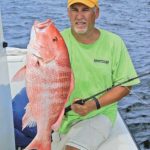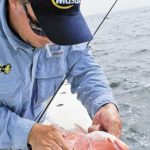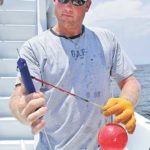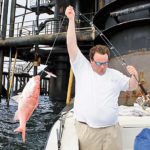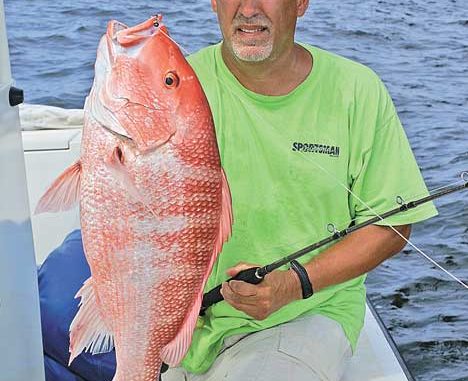
Snapper season opens this month, and it surely won’t be open long. Here’s how to get the most out of your trips to the big water.
You think red snapper fishing requires heavy fishing tackle, a ton of lead weight and messy, stinky natural baits to be successful?
Think again.
Due to reported overfishing of red snapper Gulf-wide, strict regulations and drastically reduced creel limits have been imposed in efforts to rebuild the red snapper stocks. Last year, the Louisiana season lasted just over two months.
With a creel limit of only two fish per angler, 16 inches or larger, fishermen from Texas to Florida are looking for methods to maximize the results of their offshore trips.
Two ways are to catch larger fish and minimize the expense of the trips. Contrary to traditional fishing practices for red snapper (and other reef fish), anglers across the Gulf are leaving the heavy “meat poles” and natural baits at home, and pursuing the fish with butterfly jigs and the much-lighter tackle specifically designed to fish them. It also can add a lot of fun.
“Jig fishing has been popular in other areas and countries for a long time, and now it’s exploding throughout the local fisheries,” said Jeff Pierce.
He should know. Pierce, who is affectionately known as “Dr. Fish,” is the sales manager for Mustad Hooks. He has vast fishing experience all around the world, and has used and tested all of the tackle necessary for an efficient butterfly jigging system.
Pierce was instrumental in Mustad’s commitment to jig fishing, which includes a full line of premium-assist hooks that complement jigs made by several different manufacturers.
More and more snapper fishermen are using these simple metal slabs to target bigger fish without any natural bait. Additionally, they also find that they are coming home with a wider variety of species.
“With the low limits on red snapper, using jigs to add to the bag with grouper, amberjacks and other reef fish will make your trips much more worthwhile,” Pierce said.
When fishing with natural baits, the common practice is to use whole or cut-up snapper favorites such as squid, pogies or cigar minnows. While these baits certainly catch fish, they also attract a variety of small “bait stealers” and other unwanted species such as sharks. There’s nothing more frustrating than dropping down a baited hook with a pound of lead weight only to have your bait stolen and have to reel it all the way up again.
“One of the best things about jig fishing is that if you miss a strike, you still have your bait and don’t have to reel all the way back up,” said Anthony Puglia, owner of Puglia’s Sporting Goods in Metairie.
He has seen a big increase in the sales of jigs and jigging tackle over the last few years.
A typical jigging set-up consists of a lightweight rod teamed with a spinning or casting reel designed for jig fishing. Braided line with a wind-on leader of heavy fluorocarbon is tied to the split ring on the jig’s assist hook. Jigs will have single or double assist hooks depending on user preference. The assist hooks are made with a short length of Spectra or wire.
Primary red snapper fishing locations off of Louisiana are oil and gas rigs and sunken structure such as shipwrecks. The fish will be holding at various depths, and oftentimes will be grouped by size. With larger fish sometimes below the smaller ones, it’s often difficult to get natural baits to where the bigger fish are without hooking a small one or losing your bait. The use of specifically sized jigs will help target just the fish you want to catch.
“It’s easy to count down your drop and get a big jig down through the smaller fish,” Pierce said.
Once you identify the depth where the fish are holding, it’s easy to repeat success by counting down your drop to stop your jig at the same level.
“Sometimes you will want to go all the way to the bottom; other times they may be holding nearer the surface or at some depth in between,” Pierce said.
Although jigging is not difficult, it is also not as simple as just dropping it down and reeling it back up.
“Like any other artificial bait, the fisherman has to work it in a way to fool the fish into thinking the jig is food,” Pierce said.
Jigging styles can vary widely, but generally anglers incorporate a rod-pumping action interspersed with starts and stops of reeling the line. On any given trip, the fish may prefer a different jig presentation. When you find one that is working that day, repeating it will likely bring continued success.
On a trip just near the end of last year’s snapper season, I tagged along with Pierce, Puglia and Drew Davis on Capt. Kevin Beach’s Pale Horse. After getting blown out on a tuna trip, Plan B’s jigging action provided limits of big red snapper and a boatload of amberjack, scamp and several other tasty reef fish. All were caught using butterfly jigs.
Most of the red snapper were encountered in 200 feet of water near a large oil rig. Beach positioned the boat on the downcurrent corner of the rig, and used the engines to hold position while everyone sent their jigs on a red snapper re-con mission.
Mission accomplished.
Predictably, Pierce was always the first one to hook-up. His effortless presentation more often than not resulted in a fat red snapper attached to his jig. Everyone on board soon got the hang of it, and also managed to fill their snapper limits.
One problem that regularly occurs when fish are quickly reeled up from the depths is that they suffer injury from hydrostatically induced barotrauma. Their eyes bulge and oftentimes their stomachs protrude from their mouths. This is caused by the rapid expansion of gasses in their swim bladders. Releasing a fish in this condition will almost always prove to be fatal.
That is why one of the new regulatory requirements is that a venting tool be on board and used to “vent” a fish that is to be released.
On this trip, any fish that needed to be released was handed over to Pierce for careful venting to help ensure survival. Pierce always had a large hypodermic needle in his top pocket, and would gently vent the fish while making sure all the gas was released.
“If you listen carefully, you can hear the gas coming out and can tell when it stops,” he said.
Reports from charter captains show that there is an abundance of large, hungry red snapper across the Gulf. When the season opens, no one should have difficulty filling his limit.
For a change of pace and an extra measure of challenge, leave the stinky baits at home and try tricking these fish with butterfly jigs.
Capt. Kevin Beach can be reached at (504) 451-3886.
